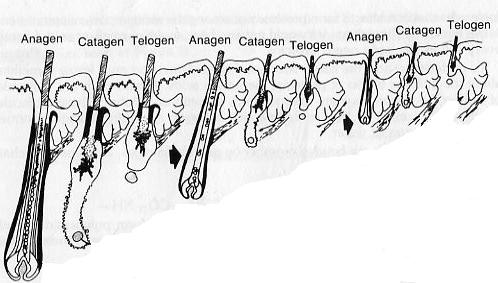Clinical Features of Male & Female Pattern Hair Loss
One of the most recognizable symptoms of male or female pattern hair loss is the progressive thinning of the hair, both the density and the diameter of the hair shaft. The hair, besides becoming finer and less dense, often is less manageable. The sufferer may also note increased oiliness and, often, symptoms of tenderness, tingling, crawling, itching, burning and uncomfortable awareness of the scalp.
Progressive Degeneration of the Hair
This above illustration represents the progressive diminution in the size of scalp follicle during balding. Our hair goes through cycles of growing and resting before falling off. For the sufferer, with each cycle, the length of the Anagen (Growing) phase reduces and the Telogen (Resting) phase becomes longer resulting in gradual thinning. This also results in thinner and shorter hair shafts with each cycle, this degeneration affects both the hair shaft as well as the hair follicle beneath the skin.
The Impact of Diet for your Hair
A healthy diet is important for hair health. Proteins are essential for growth, hair, nails and skins are proteins. Hormones, enzymes and antibodies are also proteins. While increasing the amount of protein in the diet does not necessarily increase hair growth, the lack of protein in your diet, can lead to hair loss and conditions such as dry and brittle hair.

According to the American Academy of Dermatology, calorie and/or protein malnutrition forces the body to save protein by shifting growing hairs into resting phase. This causes diffused hair loss. It is often not noticeable until nearly half of the hair is lost. Body hair, on the other hand, may increase at the same time.
A well known manifestations of the eating disorder anorexia nervosa is hair loss. In fact, dieticians have noticed that a loss of a mere five kilograms (11 lb) can lead to some hair loss, particularly if you cut down drastically on protein and/or fat.
It is important to have a diet that includes sources of Vitamin C (available from fresh fruits and vegetables) and Vitamin B (found in oily fish, peas, eggs, milk and wholegrain cereals) on a daily basis. The Vitamin B complex, and particular biotin, is important to keep hair follicles in good health. The lack of biotin (found in nuts and eggs) may adversely affect the hair follicle. Vitamin B1 is also important for healthy hair.
Although Vitamin C is not directly linked to healthy hair, it does help with absorption of iron (iron deficiency and anemia can lead to hair loss). Hair loss which results from iron deficiency is relatively common in young women who menstruate. A diet containing enough iron-rich foods, including green leafy vegetables, eggs, dates, raisins and liver is recommended during menstruation.
In large doses, Vitamin A causes hair loss, it inhibit cell division and slow down keratinization, thereby slowing down activity in the hair follicle.
Zinc deficiency is also known to lead to hair loss, so make sure you have enough in your diet (found in shellfish, red meat and pumpkin seeds). Zinc can improve thyroid function (and an underactive thyroid, may lead to thinning hair).
Supplements that can improve the condition of your hair in the long term include those containing essential fatty acids such as flaxseed and evening primrose oil. Essential fatty acids are also found in oily fish and nuts.
It makes sense that a well-balanced diet, which is good for your body, is also good for your hair.


